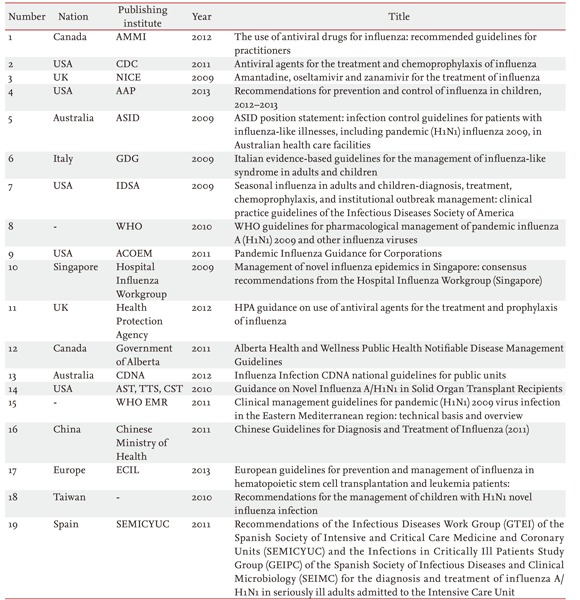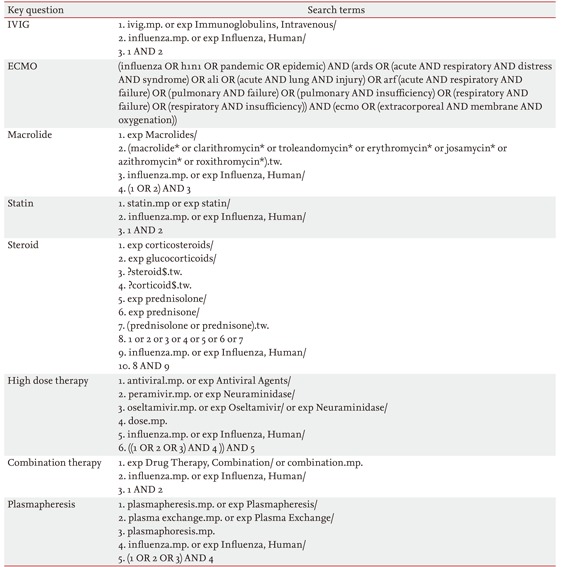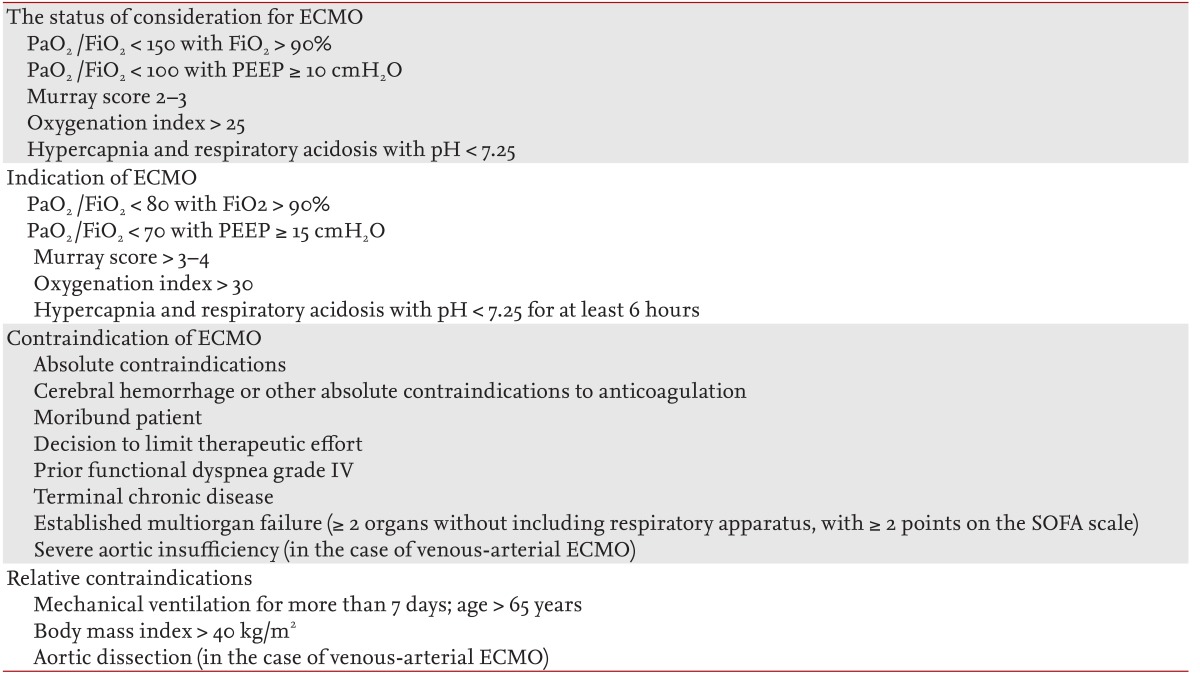1. Choi WS, Lee J, Lee HY, et al. Clinical practice guideline for antiviral treatment and chemoprophylaxis of seasonal influenza. Infect Chemother 2012;44:233ŌĆō249.

3. Hayden FG, Treanor JJ, Fritz RS, et al. Use of the oral neuraminidase inhibitor oseltamivir in experimental human influenza: randomized controlled trials for prevention and treatment. JAMA 1999;282:1240ŌĆō1246PMID : 10517426.


5. Nicholson KG, Aoki FY, Osterhaus AD, et al. Efficacy and safety of oseltamivir in treatment of acute inf luenza: a randomised controlled trial: Neuraminidase Inhibitor Flu Treatment Investigator Group. Lancet 2000;355:1845ŌĆō1850PMID : 10866439.


6. Treanor JJ, Hayden FG, Vrooman PS, et al. Efficacy and safety of the oral neuraminidase inhibitor oseltamivir in treating acute influenza: a randomized controlled trial: US Oral Neuraminidase Study Group. JAMA 2000;283:1016ŌĆō1024PMID : 10697061.


9. Lee N, Hui DS, Zuo Z, et al. A prospective intervention study on higher-dose oseltamivir treatment in adults hospitalized with influenza a and B infections. Clin Infect Dis 2013;57:1511ŌĆō1519PMID : 24046309.


10. Kim AR, Kim ES, Pai KS, Park JE. A case of high dose oseltamivir treatment in an influenza A (H1N1) infected patient with severe graft versus host disease. Clin Pediatr Hematol Oncol 2011;18:58ŌĆō61.
11. Kang SJ, Park KH, Kee SJ, et al. Virological clearance rate of high-dose oseltamivir or triple-combination antiviral therapy in complicated 2009 pandemic influenza A (H1N1) infection. Jpn J Infect Dis 2013;66:425ŌĆō427PMID : 24047743.


12. Leekha S, Zitterkopf NL, Espy MJ, Smith TF, Thompson RL, Sampathkumar P. Duration of inf luenza A virus shedding in hospitalized patients and implications for infection control. Infect Control Hosp Epidemiol 2007;28:1071ŌĆō1076PMID : 17932829.


13. Fiore AE. United States Advisory Committee on Immunization Practices. National Center for Immunization and Respiratory Diseases (US). National Center for Immunization and Respiratory Diseases (US) Influenza Division. Centers for Disease Control and Prevention (US). Antiviral Agents for the Treatment and Chemoprophylaxis of Inf luenza: Recommendations of the Advisory Committee on Immunization Practices (ACIP). Atlanta: US Dept. of Health and Human Services, Centers for Disease Control and Prevention, 2011.
14. Escuret V, Cornu C, Boutitie F, et al. Oseltamivir-zanamivir bitherapy compared to oseltamivir monotherapy in the treatment of pandemic 2009 influenza A (H1N1) virus infections. Antiviral Res 2012;96:130ŌĆō137PMID : 22909899.


20. Petersen E, Keld DB, Ellermann-Eriksen S, et al. Failure of combination oral oseltamivir and inhaled zanamivir antiviral treatment in ventilator- and ECMO-treated critically ill patients with pandemic influenza A (H1N1)v. Scand J Infect Dis 2011;43:495ŌĆō503PMID : 21309638.


21. Del Mar CB, Glasziou PP, Spinks AB. Antibiotics for sore throat. Cochrane Database Syst Rev 2004;2:CD000023. PMID : 15106140.

22. Smucny J, Fahey T, Becker L, Glazier R. Antibiotics for acute bronchitis. Cochrane Database Syst Rev 2004;4:CD000245. PMID : 15494994.

23. Spurling GK, Del Mar CB, Dooley L, Foxlee R, Farley R. Delayed antibiotics for respiratory infections. Cochrane Database Syst Rev 2013;4:CD004417. PMID : 23633320.

24. Morciano C, Vitale A, De Masi S, et al. Italian evidence-based guidelines for the management of influenza-like syndrome in adults and children. Ann Ist Super Sanita 2009;45:185ŌĆō192PMID : 19636171.

25. Centers for Disease Control and Prevention (CDC). Surveillance for pediatric deaths associated with 2009 pandemic inf luenza A (H1N1) virus infection: United States, April-August 2009. MMWR Morb Mortal Wkly Rep 2009;58:941ŌĆō947PMID : 19730406.

26. Wright PF, Kirkland KB, Modlin JF. When to consider the use of antibiotics in the treatment of 2009 H1N1 inf luenza-associated pneumonia. N Engl J Med 2009;361:e112. PMID : 19940288.


27. Song JH, Jung KS, Kang MW, et al. Treatment guidelines for community-acquired pneumonia in Korea: an evidence-based approach to appropriate antimicrobial therapy. Infect Chemother 2009;41:133ŌĆō153.

28. Korean Otologic Society. Korean Clinical Practice Guideline: Otitis Media in Children 2010. Seoul: Korean Otologic Society, 2010.
29. Paden ML, Conrad SA, Rycus PT, Thiagarajan RR. ELSO Registry. Extracorporeal life support organization registry report 2012. ASAIO J 2013;59:202ŌĆō210PMID : 23644605.


30. Sadahiro T, Oda S, Nakamura M, et al. Trends in and perspectives on extracorporeal membrane oxygenation for severe adult respiratory failure. Gen Thorac Cardiovasc Surg 2012;60:192ŌĆō201PMID : 22451141.


31. Rodr├Łguez A, Alvarez-Rocha L, Sirvent JM, et al. Recommendations of the Infectious Diseases Work Group (GTEI) of the Spanish Society of Intensive and Critical Care Medicine and Coronary Units (SEMICYUC) and the Infections in Critically Ill Patients Study Group (GEIPC) of the Spanish Society of Infectious Diseases and Clinical Microbiology (SEIMC) for the diagnosis and treatment of inf luenza A/H1N1 in seriously ill adults admitted to the Intensive Care Unit. Med Intensiva 2012;36:103ŌĆō137PMID : 22245450.


32. Michaels AJ, Hill JG, Bliss D, et al. Pandemic flu and the sudden demand for ECMO resources: a mature trauma program can provide surge capacity in acute critical care crises. J Trauma Acute Care Surg 2013;74:1493ŌĆō1497PMID : 23694877.


34. Pappalardo F, Pieri M, Greco T, et al. Predicting mortality risk in patients undergoing venovenous ECMO for ARDS due to inf luenza A (H1N1) pneumonia: the ECMOnet score. Intensive Care Med 2013;39:275ŌĆō281PMID : 23160769.


36. Roncon-Albuquerque R Jr, Basilio C, Figueiredo P, et al. Portable miniaturized extracorporeal membrane oxygenation systems for H1N1-related severe acute respiratory distress syndrome: a case series. J Crit Care 2012;27:454ŌĆō463PMID : 22386225.


37. Brink M, Hagberg L, Larsson A, Gedeborg R. Respiratory support during the influenza A (H1N1) pandemic flu in Sweden. Acta Anaesthesiol Scand 2012;56:976ŌĆō986PMID : 22724889.


38. Hou X, Guo L, Zhan Q, et al. Extracorporeal membrane oxygenation for critically ill patients with 2009 influenza A (H1N1)-related acute respiratory distress syndrome: preliminary experience from a single center. Artif Organs 2012;36:780ŌĆō786PMID : 22747918.


39. Shetty AK, Ross GA, Pranikoff T, et al. Oseltamivir-resistant 2009 H1N1 inf luenza pneumonia during therapy in a renal transplant recipient. Pediatr Transplant 2012;16:E153ŌĆōE157PMID : 22764830.


41. Morgan CI, Hobson MJ, Seger B, Rice MA, Staat MA, Wheeler DS. 2009 pandemic influenza A (H1N1) in critically ill children in Cincinnati, Ohio. Pediatr Crit Care Med 2012;13:e140ŌĆōe144PMID : 21760562.


42. Bonastre J, Suberviola B, Pozo JC, et al. Extracorporeal lung support in patients with severe respiratory failure secondary to the 2010-2011 winter seasonal outbreak of influenza A (H1N1) in Spain. Med Intensiva 2012;36:193ŌĆō199PMID : 22341559.


43. Lemaitre F, Luyt CE, Roullet-Renoleau F, et al. Impact of extracorporeal membrane oxygenation and continuous venovenous hemodiafiltration on the pharmacokinetics of oseltamivir carboxylate in critically ill patients with pandemic (H1N1) inf luenza. Ther Drug Monit 2012;34:171ŌĆō175PMID : 22354159.


44. Beurtheret S, Mastroianni C, Pozzi M, et al. Extracorporeal membrane oxygenation for 2009 inf luenza A (H1N1) acute respiratory distress syndrome: single-centre experience with 1-year follow-up. Eur J Cardiothorac Surg 2012;41:691ŌĆō695PMID : 22228837.


45. Azevedo LC, Park M, Costa EL, et al. Extracorporeal membrane oxygenation in severe hypoxemia: time for reappraisal? J Bras Pneumol 2012;38:7ŌĆō12PMID : 22407035.


46. Li HL, Meng C, Zhu X, Guo LM, Li BS. The application of extracorporeal membrane oxygenation in critically ill patient. Zhongguo Wei Zhong Bing Ji Jiu Yi Xue 2012;24:86ŌĆō89PMID : 22316539.

47. van Ierssel SH, Leven M, Jorens PG. Severe influenza A (H1N1) 2009 infection: a single centre experience and review of the literature. Acta Clin Belg 2012;67:1ŌĆō6PMID : 22480031.


49. Lee KH, Yie K, Oh WS, Ryu SW, Chon SB, Lee SJ. Early extracorporeal membrane oxygenation in a patient with pandemic influenza (H1N1 2009) and acute respiratory distress syndrome. Infect Chemother 2010;42:122ŌĆō126.

50. Dom├Łnguez-Cherit G, Lapinsky SE, Macias AE, et al. Critically Ill patients with 2009 influenza A (H1N1) in Mexico. JAMA 2009;302:1880ŌĆō1887PMID : 19822626.


51. Quispe-Laime AM, Bracco JD, Barberio PA, et al. H1N1 influenza A virus-associated acute lung injury: response to combination oseltamivir and prolonged corticosteroid treatment. Intensive Care Med 2010;36:33ŌĆō41PMID : 19924393.


53. Sohn YR, Kim JH, Ma SH, Lee KY, Kang JH. Severe pneumonia caused by 2009 pandemic inf luenza A (H1N1) virus in children and corticosteroid treatment. Korean J Pediatr Infect Dis 2011;18:193ŌĆō200.

55. Confalonieri M, Cifaldi R, Dreas L, Viviani M, Biolo M, Gabrielli M. Methylprednisolone infusion for life-threatening H1N1-virus infection. Ther Adv Respir Dis 2010;4:233ŌĆō237PMID : 20639272.


56. Ohtsuki N, Kimura S, Nezu A, Aihara Y. Effects of mild hypothermia and steroid pulse combination therapy on acute encephalopathy associated with inf luenza virus infection: report of two cases. No To Hattatsu 2000;32:318ŌĆō322PMID : 10916371.

57. Hibino M, Akazawa K, Hikino K, Oe M. A case of acute respiratory distress syndrome associated with pandemic influenza A (H1N1) pneumonia which was aggravated by the cessation of corticosteroid therapy. Nihon Kokyuki Gakkai Zasshi 2011;49:955ŌĆō963PMID : 22352059.

58. Samejima T, Takayanagi N, Ishiguro T, Miyahara Y, Yanagisawa T, Sugita Y. Case of novel influenza A (H1N1) pneumonia with shrinkage of a pulmonary lesion. Nihon Kokyuki Gakkai Zasshi 2010;48:930ŌĆō937PMID : 21226300.

59. Ishiguro T, Takayanagi N, Kanauchi T, Hoshi T, Yanagisawa T, Sugita Y. Two patients with novel influenza A virus (H1N1) pneumonia treated with steroid therapy after an incorrect diagnosis of rapid progressive interstitial pneumonia due to the negative results of a rapid-antigen test. Nihon Kokyuki Gakkai Zasshi 2010;48:687ŌĆō695PMID : 20954372.

60. Sakurai T, Kimura A, Tanaka Y, Hozumi I, Ogura S, Inuzuka T. Case of adult influenza type A virus-associated encephalopathy successfully treated with primary multidisciplinary treatments. Rinsho Shinkeigaku 2007;47:639ŌĆō643PMID : 18095496.

61. Djibr├® M, Berkane N, Salengro A, et al. Non-invasive management of acute respiratory distress syndrome related to Influenza A (H1N1) virus pneumonia in a pregnant woman. Intensive Care Med 2010;36:373ŌĆō374PMID : 19820915.


62. Ando M, Miyazaki E, Hiroshige S, et al. Virus associated hemophagocytic syndrome accompanied by acute respiratory failure caused by influenza A (H3N2). Intern Med 2006;45:1183ŌĆō1186PMID : 17106167.


63. Athauda D, Andrews TC, Holmes PA, Howard RS. Multiphasic acute disseminated encephalomyelitis (ADEM) following influenza type A (swine specific H1N1). J Neurol 2012;259:775ŌĆō778PMID : 21997495.


64. Wang Y, Lu YY, Zheng J, Da W, Ping C, Da DZ. Treatment of critically ill influenza A H1N1 patients in plateau region. Zhongguo Wei Zhong Bing Ji Jiu Yi Xue 2010;22:153ŌĆō155PMID : 20367905.

65. Kawashima H, Togashi T, Yamanaka G, et al. Efficacy of plasma exchange and methylprednisolone pulse therapy on inf luenza-associated encephalopathy. J Infect 2005;51:E53ŌĆōE56PMID : 16038752.


66. Munakata M, Kato R, Yokoyama H, et al. Combined therapy with hypothermia and anticytokine agents in influenza A encephalopathy. Brain Dev 2000;22:373ŌĆō377PMID : 11042419.


67. Roberts C, Nirmalan M, O'Shea S. Steroid-sensitive post-viral inflammatory pneumonitis (PVIP). Am J Respir Crit Care Med 2010;182:1089ŌĆō1090PMID : 20947911.


68. Martin-Loeches I, Lisboa T, Rhodes A, et al. Use of early corticosteroid therapy on ICU admission in patients affected by severe pandemic (H1N1) v influenza A infection. Intensive Care Med 2011;37:272ŌĆō283PMID : 21107529.


69. Mady A, Ramadan OS, Yousef A, Mandourah Y, Amr AA, Kherallah M. Clinical experience with severe 2009 H1N1 influenza in the intensive care unit at King Saud Medical City, Saudi Arabia. J Infect Public Health 2012;5:52ŌĆō56PMID : 22341843.


70. Linko R, Pettila V, Ruokonen E, et al. Corticosteroid therapy in intensive care unit patients with PCR-confirmed inf luenza A (H1N1) infection in Finland. Acta Anaesthesiol Scand 2011;55:971ŌĆō979PMID : 22092165.


71. Han K, Ma H, An X, et al. Early use of glucocorticoids was a risk factor for critical disease and death from pH1N1 infection. Clin Infect Dis 2011;53:326ŌĆō333PMID : 21810744.


72. Marav├Ł-Poma E, Martin-Loeches I, Regidor E, et al. Severe 2009 A/H1N1v influenza in pregnant women in Spain. Crit Care Med 2011;39:945ŌĆō951PMID : 21263317.


73. Kawashima H, Morichi S, Okumara A, Nakagawa S, Morishima T. Collaborating Study Group on Influenza-Associated Encephalopathy in Japan. Treatment of pandemic influenza A (H1N1) 2009-associated encephalopathy in children. Scand J Infect Dis 2012;44:941ŌĆō947PMID : 22830454.


74. Brun-Buisson C, Richard JC, Mercat A, Thiebaut AC, Brochard L. REVA-SRLF A/H1N1v 2009 Registry Group. Early corticosteroids in severe influenza A/H1N1 pneumonia and acute respiratory distress syndrome. Am J Respir Crit Care Med 2011;183:1200ŌĆō1206PMID : 21471082.


75. Kim SH, Hong SB, Yun SC, et al. Corticosteroid treatment in critically ill patients with pandemic influenza A/H1N1 2009 infection: analytic strategy using propensity scores. Am J Respir Crit Care Med 2011;183:1207ŌĆō1214PMID : 21471084.


76. Diaz E, Martin-Loeches I, Canadell L, et al. Corticosteroid therapy in patients with primary viral pneumonia due to pandemic (H1N1) 2009 influenza. J Infect 2012;64:311ŌĆō318PMID : 22240033.


77. Chong JL, Sapari S, Kuan YC. A case of acute respiratory distress syndrome associated with novel H1N1 treated with intravenous immunoglobulin G. J Microbiol Immunol Infect 2011;44:319ŌĆō322PMID : 21524955.


78. Gordon CL, Langan K, Charles PG, et al. Pooled human immunoglobulin therapy in critically Ill patients with pandemic 2009 inf luenza A(H1N1) pneumonitis and immunoglobulin G2 subclass (IgG2) deficiency. Clin Infect Dis 2011;52:422ŌĆō426PMID : 21217191.

79. Iwanaga N, Nakamura S, Tanaka A, et al. An adult case of influenza-associated encephalitis successfully treated with high dose intravenous immunoglobulins. Kansenshogaku Zasshi 2012;86:295ŌĆō299PMID : 22746053.


80. Zhang R, Jin L, Jin M, et al. Clinical analysis of children with lymphoma complicated with severe pneumonia due to novel influenza A (H1N1) virus infection. Zhonghua Er Ke Za Zhi 2010;48:610ŌĆō613PMID : 21055307.

81. Terblanche M, Almog Y, Rosenson RS, Smith TS, Hackam DG. Statins and sepsis: multiple modifications at multiple levels. Lancet Infect Dis 2007;7:358ŌĆō368PMID : 17448939.


82. Vandermeer ML, Thomas AR, Kamimoto L, et al. Association between use of statins and mortality among patients hospitalized with laboratory-confirmed influenza virus infections: a multistate study. J Infect Dis 2012;205:13ŌĆō19PMID : 22170954.


84. Frost FJ, Petersen H, Tollestrup K, Skipper B. Influenza and COPD mortality protection as pleiotropic, dose-dependent effects of statins. Chest 2007;131:1006ŌĆō1012PMID : 17426203.


86. Carrillo-Esper R, Sosa-Garcia JO, Arch-Tirado E. Experience in the management of the severe form of human influenza A H1N1 pneumonia in an intensive care unit. Cir Cir 2011;79:409ŌĆō416PMID : 22385760.

87. Viasus D, Pano-Pardo JR, Cordero E, et al. Effect of immunomodulatory therapies in patients with pandemic influenza A (H1N1) 2009 complicated by pneumonia. J Infect 2011;62:193ŌĆō199PMID : 21295604.











 PDF Links
PDF Links PubReader
PubReader ePub Link
ePub Link Full text via DOI
Full text via DOI Download Citation
Download Citation Print
Print





